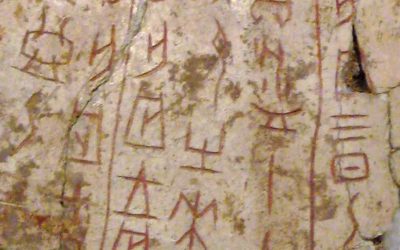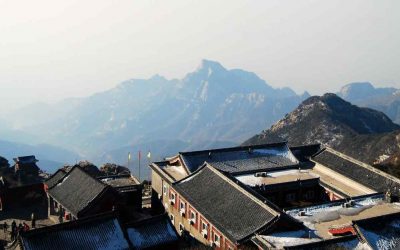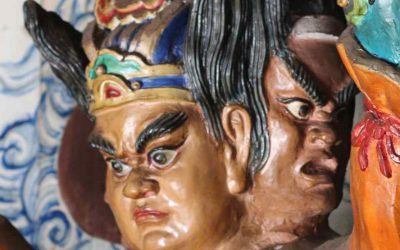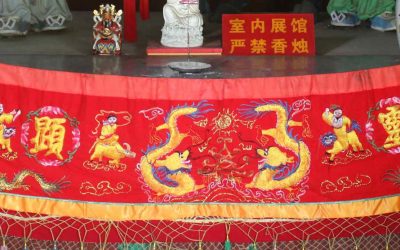Cheng Naishan. The Blue House. Panda Books. 1989.
«Cheng Naishan captivates readers with stories about the present lives of Shanghai capitalists, who have overcome 30 years of political vicissitudes, as well as the lives of their children.» So begins the presentation in this work on the back cover of the book, and this already gives us an idea of the character of these narratives, which are girded to life in Shanghai, to a very particular historical moment, the one following the end of the Cultural Revolution and about a social class also very particular, the descendants of some wealthy families from before the Revolution who arrived impoverished at the new awakening of capitalism in China.
This historical time frame is the book’s greatest virtue and at the same time its greatest defect, since we could say that on the one hand, it is recommendable for anyone interested in knowing Shanghai, those who have lived in the city, or those who feel something special for it, since the author describes a local reality that is difficult to discover for foreigners, no matter how many years they have lived in the city. But at the same time, this framework forces a limit on these novels, that of the historical moment in which they take place, the 1980s, years that present great transformations in the lives of the people. Cheng Naishan describes with great mastery the contradictions at a very specific moment in the history of the city, in some people in whom we find on the one hand the remains of the aristocratic mentality before the revolution, the germ of a new primitive capitalism that slowly emerges with the new policies, in which the greatest economic advantage is to have someone abroad who regularly sends hard currency, and the last traces of the system that developed during the Cultural Revolution.
Framing the narratives in such a concrete and brief historical period, barely 10 years, is practically both an advantage and a handicap since, on the one hand, it allows us to know the contradictions suffered by the people who had once belonged to the upper classes, who have seen their privileges suppressed and are not integrated into the new structure proposed by the party, because their education still kept them a bit distant from the rest of the people. But the disadvantage of this narrow temporal space location is that it becomes a little difficult for the reader to identify with the protagonists, because the city immediately changed, so much so that these small miseries, these small sufferings, since they are much smaller than the great tragedies so often described in the experiences of the Cultural Revolt or the Great Leap Forward, do not touch our hearts.
So neither do we find ourselves with those tragedies that could have moved us, as in the works that deal with other historical periods much more violent and much better defined nor do we find ourselves with ideas that we could call universal since the author does not really intend to generalize these experiences.
In the characters of the 3 novelettes and the short story contained in this book there is a general anxiety about money, about escaping from the tiny dwellings, from a world in which there is a perceived lack of opportunities and in which it seems that it is not enough to have overcome the horrors of the Cultural Revolution, but that material progress, present in small and large household appliances and other material goods, must be achieved immediately. In this context it is not easy to identify with the protagonists, it is difficult to empathize with their yearnings, with their aspirations, but the reader remains an involuntary witness of the actions of a group of people out of step with their times. Since these material yearnings were satisfied in the years immediately after, it gives it a character that is too ephemeral, too temporary.
It is hard for us to identify with these people who suffer small tragedies because of their excessive dependence on money and material conditions, conditions that only reveal themselves to be essentially miserable when compared to the old mansions that some old families are recovering. They seem to us to be intellectually poor as a rule, and they themselves discover that poverty sometimes tragically, but only a little tragically.
For example in The Blue House, which gives the book its title, is where one can discover greater quality because it shows a perhaps more powerful story and at the same time it could be seen as a tale of initiation, the protagonist seeks with such great longing an immediate economic improvement to show himself worthy before the young woman he loves, who loses it precisely because of that emphasis on money.
The second story, The Poor Street, could be said to describe the adaptation of the ideals of a middle-class young lady who ends up realizing that she is not so out of place working as a teacher in one of the poorest neighborhoods of Shanghai.
The third, Daughters’ Tribulations, is perhaps the most exemplary of the contradictions that were experienced in Shanghai at that time by this kind of people.
But I have said that the book is necessary reading for all those who want to know Shanghai because it is precisely a portrait of the recent history of this city, which can help to understand many of the characteristics that occurred later, such as the recovery of many companies by the original owners and of many houses, and well, and a little of how this process of social transformation took place, which in just a decade left the city and its inhabitants unrecognizable.
Last posts
The dog in China’s ancient tombs
Pedro Ceinos Arcones. La Magia del perro en China y el mundo. Dancing Dragons Books. 2019. (Excerpts from the book) The dog in China’s ancient tombs In China, dogs buried with their owners have been discovered in archaeological sites belonging to the most important...
Some philosophical schools in Buddha’s times
Peter Harvey. Buddhism: Teachings, History and Practices. Cambridge University Press. 2013. (Excerpts from the book. Page 11 and ff.) In its origin, Buddhism was a Samana-movement. Samanas were wandering ‘renunciant’ thinkers who were somewhat akin to the early Greek...
The origin of Chinese characters
The origin of Chinese characters in John C. Didier, “In and Outside the Square,” Sino-Platonic Papers, 192, vol. 1 (September, 2009) The technology of writing appears suddenly and morphologically fully developed on Shang oracle bones and, later, bronzes at about the...
The sacred Taishan mountain
Taishan Mountain, life and death in Chinese culture, according to the work of Edouard Chavannes Mountains are, in China, divinities. They are considered as nature powers who act in a conscious way and who can, therefore, be made favourable by sacrifices and touched...
A Taoist exorcism séance
'My friend is going to conclude an exorcism service this morning and, if you are really so interested, he hopes you can come and witness it.' He paused uncertainly. 'But I must warn 86 you that it is not a pretty sight. Really it is most unpleasant, disgusting and...
Chinese superstitions before the birth
To have five sons, rich, vigorous, literate and who become mandarins: this is the ideal of any Chinese family. From this matrix idea emerged the various types of popular images that are displayed in all households: Wu Zi Deng Ke (五子登科), Have five official children!...










